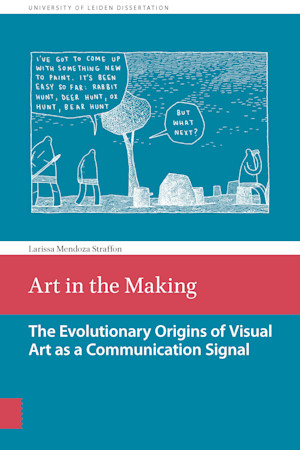
L. Mendoza Straffon
Art in the Making
The evolutionary origins of visual art as a communication signal
The corpus of art from the Pleistocene has grown substantially in recent decades, and with it, the earliest evidence of visual art has become much older than previously anticipated, going back over 100,000 years. This new information has rendered some traditional ideas about the recent origins of visual art obsolete. Existing archaeological and evolutionary models that aim to explain the mergence of visual art should now be reassessed in light of current data. That is the aim of this book. First, it reviews the earliest examples of different forms of visual art in two important archaeological periods of human artistic innovation, the height of the African Middle Stone Age, and the European Early Upper Palaeolithic. It then takes a critical view at three influential origins-of-art models, namely, the sexual selection model, the social cohesion model, and the cognitive evolution model. Finally, it offers an alternative proposal that redefines visual art as a communication signal and, using the archaeological evidence, relates its emergence and development to the evolution of human cooperation strategies. This book will appeal to anyone interested in the debate of the origins of art and the evolution of modern human cognition, behaviour, and culture.
+
Purchase from Taylor & Francis 
Our titles are distributed through Taylor & Francis
Author
- Title
- Art in the Making
- Subtitle
- The evolutionary origins of visual art as a communication signal
- Author
- L. Mendoza Straffon
- Price
- € 41,95 excl. VAT
- ISBN
- 9789085550907
- Format
- Paperback
- Number of pages
- 234
- Language
- English
- Publication date
- 25 - 09 - 2014
- Dimensions
- 15.6 x 23.4 cm
- Category
- Modern History
- Discipline
- History, Art History, and Archaeology
Acknowledgements
Preface
Chapter 1
Art unfolding: Studying the origins of visual art
1.1 Pleistocene visual art: An outline of definitions
1.2 Research approaches to the origins of art
1.3 Cooperation as and explanatory framework of human evolution
Chapter 2
From the cradle to the cave: A survey of Pleistocene visual art
2.1 Archaeological periods in focus: The MSA and EUP
2.2 Pleistocene visual art: Identification and attribution
2.3 Tracing the origins of Pleistocene visual art: A general survey
2.4 Trends in the development of Pleistocene visual art
2.5 Conclusion
Chapter 3
The art of courtship: Geoffrey Miller's mate choice model
3.1 Sexual selection and mate choice theory: The background
3.2 The bowerbird and the artist: Key arguments
3.3 Visual art as a courtship display: Critical assessment
3.4 Test against the archaeological record of visual art
3.5 Conclusion
Chapter 4
Life Artified: Ellen Dissanayake's ethological model
4.1 The biological study of behaviour: The background
4.2 The artification hypothesis: Key arguments
4.3 What is art for? Critical assessment
4.4 Test against the archaeological record of visual art
4.5 Conclusion
Chapter 5
Art in mind: Steven Mithen's model of cognitive evolution
5.1 The evolution of human cognition: The background
5.2 The prehistory of the mind: Key arguments
5.3 A mind for art: Critical assessment
5.4 Test against the archaeological record of visual art
5.5 Conclusion
Chapter 6
Art signals: Communication, cooperation, and the origins of visual art
6.1 Visual art as a communication signal
6.2 Who art thou? Cooperation, memory & identity
6.3 The borne identity: Visual art's origins
6.4 Test against the archaeological record of visual art
6.5 Conclusion
Concluding Remarks
Summary of the chapters
Limitations of the research
Suggestions for future research
Final reflections
Bibliography
Summary in Dutch
Curriculum Vitae




